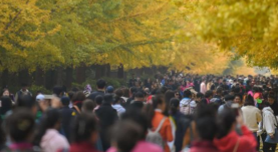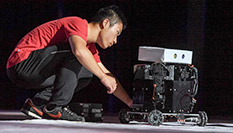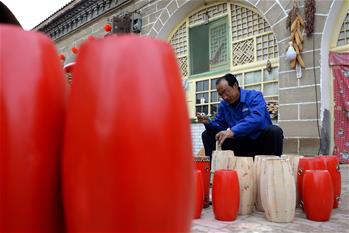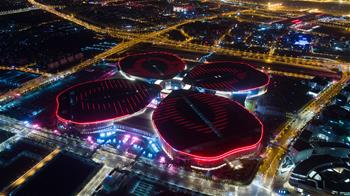秋意渐浓,本该是赏枫的时节,但日本的樱花却在这个时候绽放了。樱花在春天盛开让人欣喜,在秋天开花却引人担忧。专家称,近日袭击日本的强台风导致的气温异常让樱树混淆了开花时间,从而出现大片樱树反季开花的现象。
Every spring, cherry blossoms bloom in Japan, and it is an occasion for national celebration. Picnics, picture-taking, parties, and excursions to observe the trees in all their ephemeral glory abound. The traditional nature festivities are enjoyed by people of all ages and visitors from around the world who come to enjoy hanami, or flower viewing.
每年春天日本樱花盛开时,是日本举国欢庆的时节。人们会在樱树下野餐、照相、举行赏花会、短途旅游,欣赏转瞬即逝的樱花盛景。各个年龄层的日本人和世界各地前来赏樱的游客都会参加樱花节的传统庆祝活动。
However, when the trees bloom in fall—as an unusually large number of them have done this season—it could be cause for concern. Due to extreme weather and a slew of recent typhoons, most notably the destructive Typhoon Jebi, which hit in early September, it seems some iconic trees have grown confused, sprouting flowers off-schedule.
但是,当樱树在秋天开花时,却引发了人们的担忧。今年日本的多棵樱树都在秋天开花,这是十分异常的现象。由于极端天气和近日台风的频繁侵袭,尤其是九月初袭击日本的强破坏性台风“飞燕”,一些樱树似乎搞错了季节,在反季开花。
While the phenomenon is not unheard of, it seems lots of trees have bloomed very early in Tokyo this autumn. As Hiroyuki Wada of the Flower Association of Japan told broadcaster NHK, “This has happened in the past, but I don’t remember seeing something of this scale.”
虽然这种现象以前也有过先例,但今年东京似乎有许多樱树都在早秋开花了。日本花卉协会的和田博之告诉广播机构日本放送协会说:“过去也曾发生过这种情况,但我不记得看过这么多樱树在秋天开花。”
Wada posits that warm weather caused by typhoons may have confused the trees. He notes, too, that many trees lost their foliage during storms and the leaves of the cherry blossom tree release a hormone that prevents budding except in spring. The trees only bloom once a year, so an autumnal display bars the traditional spring blossoms from appearing on the same tree.
和田的理论是,台风过后当地温度升高,让樱树混淆了开花的时间。他也指出,台风带来的暴风雨使得许多樱树的叶子掉落,而樱树的叶子会释放出一种激素,让樱树只在春季长出花蕾。樱树一年只开花一次,所以秋天开过花的樱树明年春天到了传统的开花时节就不会再开花。
The meteorological company Weathernews says that more than 300 individuals in Tokyo have reported autumnal blossoms, although it’s not clear the extent to which these reports overlap. Wada says that the traditional viewing season should not be seriously impacted by the unusual display of blossoms.
日本气象株式会社称,东京有超300人报告称今秋看到了樱树开花,不过这些统计的人数中可能有重复。和田说,这一反常开花现象对明年的传统赏樱季应该影响不大。
The cherry blossom forecast, published annually by the Japan Meteorological Corporation, has not yet been released for 2019. Kyuhoshi, a travel website, says, “This year, sakura have bloomed earlier than average.”
日本气象新闻公司尚未发布2019樱花花期年度预报。旅游网站Kyuhoshi称:“今年樱花开得比往年更早一些。”
Traditionally, the sakura-viewing celebrations were meant to highlight the temporal beauty of nature. The flower viewing parties are believed to have started in the eighth century in Kyoto, initiated by the emperor Saga, who would hold picnics under the springtime blossoms. The festivities began in the daytime and sometimes continued late into the night, as guests enjoyed sake and the sight of the blooms by the light of the moon.
传统上,赏樱庆祝活动的目的是让人们品味大自然转瞬即逝的美。据称,赏花会是8世纪在京都兴起的,由嵯峨天皇发起,在春天的樱花树下野餐。赏花会从白天开始,有时延续到深夜,宾客们在月光下一边喝清酒,一边欣赏樱花美景。
Extreme weather adds a new twist to the traditional reasoning behind appreciating the cherry blossoms mother nature offers. Now we know that her beauty is not only transient, a treat to be appreciated when she deigns to share her gifts on a brief annual basis, but that she is also surprising. Her delights may come when they are not expected and her treasures, it seems, are not always bound by strict schedules.
极端天气为我们欣赏大自然母亲馈赠的樱花美景在传统含义上又添了一层新意。现在,我们了解到,大自然的美不仅是转瞬即逝,一年只分享一次的珍贵礼物,而且还是出人意料的。大自然的馈赠可能会不期而至,而她的珍宝也不会一直固守四季伦常。
英文来源:Quartz
翻译&编辑:丹妮

-
大数据"坑熟客",技术之罪需规则规避
2018-03-02 08:58:39
-
高质量发展,怎么消除“游离感”?
2018-03-02 08:58:39
-
学校只剩一名学生,她却坚守了18年
2018-03-01 14:40:53
-
有重大变动!骑共享单车的一定要注意了
2018-03-01 14:40:53
-
2018年,楼市会有哪些新变化?
2018-03-01 09:01:20










